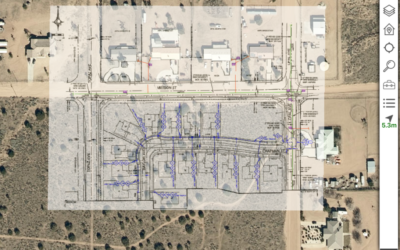The demand for maps in everyday business operations has grown over the last decade.
Investing in geoenablement brings new capabilities to your operations. Historically, technology and operational silos have made the process of integrating business and location data a challenging task. Newer technology is making this easier than ever. Realizing value from geoenablement by investing in GIS-SAP integration is now quicker and easier reducing the time and cost necessary to see the benefits.
Industry case studies show the costs of geoenablement can be recouped via direct and indirect financial and efficiency gains. Some examples of the value that can be realized quickly include:
- Uncover new data trends through a map for back office planning and decision making.
- Operate safer and more efficiently in the field through situational awareness and wayfinding on a map.
- Reduce costly downtime through predictive maintenance enabled by mapping analytics and root cause analysis.
- Easier and improved reporting using maps and dashboards.
Optimizing Data Driven Operations Using a Geoenablement Approach

The true value of geoenablement is found in the increased efficiency and improved decision-making enabled by map driven business operations. Enabling the gateway to integrated information through the map decreases operational risks through situational awareness. The geoenablement approach also increases transparency and compliance through improved data insights and management processes. Planning and operations becomes more efficient and effective through improved data accessibility and optics.
Breaking down information silos with geoenablement starts with identifying where information is managed across the enterprise and how it can be tied together through location. Even asset information that might not have an obvious location can be tied to a geographic location. Examples include operational units, physical location of other related assets, or hierarchical relationships to other pieces of business information. For example, a gas valve has many geographic relationships: it’s relationship to the pipe it serves, other pipes in the system, the customer area it serves, the regulatory reporting jurisdiction where it resides, the area of maintenance responsibility, and it’s location relationship to other data points like flood plains, and so on. The key to breaking down silos is identifying the system that maintains the information, how it is related to location, and how that relationship can be established and maintained across systems through GIS data synchronization. GIS data synchronization is the foundation of a geoenabled unified enterprise platform.

GIS Data Synchronization: The Foundation of Geoenablement
Synchronization is the alignment of master data between Esri and SAP systems of record. This alignment is the foundation to successful geoenablement and is necessary to keep both systems current, accurate, aligned, and authoritative. There are several synchronization approaches available including products, accelerators, and bespoke solutions. Locana has enabled GIS-SAP synchronization using varieties of each of these approaches and are experts at recommending a synchronization approach that meets an organization’s business and technical requirements. The key to successful geoenablement is to build the unified enterprise platform on a solid data synchronization strategy that respects each system’s APIs and business rules. The first step an organization takes in establishing a unified enterprise platform through geoenablement should be implementing GIS data synchronization.
Unifying the Enterprise Platform with a Geoenabled System of Engagement
Locana’s recommended approach for geoenablement has evolved as Esri and SAP technology has advanced. Our experience has allowed us to identify and leverage the best fit use of Esri and SAP technology for geoenablement. The investment by SAP and Esri to leverage HANA as a supported database platform for Esri’s geodatabase has unlocked significant improvements for geoenablement capabilities. SAP’s HANA platform capabilities gives easier access to SAP business data and workflows to the Esri platform. For example, Esri’s ArcGIS Enterprise and Web AppBuilder can be used to design and configure targeted mapping applications that can enable accessing SAP data and transactions from a map. Technology advances have made it easier to unify the Esri and SAP platforms to break down technical and operational silos through geoenablement.
The value of geoenablement can be unlocked in a matter of weeks through a stepwise approach of enabling an Esri system of engagement (SOE) on the SAP HANA platform without disruption to legacy Esri systems of record (SOR) on other database platforms. Enabling an SOE on the HANA platform unlocks the capabilities of the unified enterprise platform such as HANA processing improvements and access to SAP business data and processes from a map. Benefits customers can realize from taking this first step include the capabilities of:
- Seeing and interacting with SAP data from a map
- Launching targeted SAP transactions and workflows from the map
- Adding established Esri data, web maps, and widgets to workflows
- Using Esri functions such as network tracing and spatial analytics to drive SAP workflows
When an organization is ready, the Esri system of record can be migrated to the ArcGIS on HANA platform as well. Since HANA is a supported database platform for the Esri geodatabase, most GIS data management workflows can be migrated to the ArcGIS on HANA platform, decreasing the organization’s need for licensing for other legacy database platforms.
Locana sageSM: Geoenablement Using the Unified Enterprise Platform

sageSM is Locana’s solution-based approach to geoenablement that brings together Esri and SAP platform capabilities. sage, or Smart Access GeoEnablement, facilitates the creation of targeted mapping applications built on shared Esri and SAP information and technology. sage allows you to realize the value of your investments in Esri and SAP HANA quickly through targeted deployment of map-centric tools. sage enables shared, near real-time information using familiar Esri technologies such as web-based maps, widgets, dashboards, and analytic data products. sage capabilities break down technical and operational silos, giving users a streamlined platform experience. Viewing, managing, and interacting with SAP business data can be done from Esri web maps. Esri widgets allow users to launch into SAP transactions and workflows from the map interface. By using repeatable patterns, an organization can quickly and efficiently develop and deploy new web maps that support specific business workflows or user groups. Since geometry and linkages for SAP objects are stored in the Esri Geodatabase on HANA, SAP business data can also be used in Esri’s desktop tools such as ArcGIS Pro for advanced analytics or high-end map production. sage can be used with SAP Geoenablement Framework (GEF) as a way to extend mapping tools and geospatial analytic capabilities of SAP geoenabled data.
Benefits of Geoenablement Across the Enterprise
Locana has identified three areas where geoenablement of a unified enterprise platform brings significant return on investment through improved insights, business process, and data optics: Back Office, Mobility, and Analytics.
Back Office
Effective back office planning and operations is key to efficient management and accountability of financial and staff resources. Users of both the SAP and GIS systems benefit from shared insights when data is unified on the enterprise platform using sage. Demonstrating these benefits is a cornerstone of Locana’s mission around geoenablement.
Figure 1 shows an example of how Esri tools, like a utility trace, can be used from the map to show what customers would be impacted by a valve repair along a gas network. From the map view, the back- office planner can then launch SAP transactions to notify the customers of the outage, as well as work orders to have pilot lights relighted. The back office planner can use the map to launch necessary workflows related to the valve repair.

Figure 1: sage interface with Utility Network Trace
Mobility
Mobility solutions extend SAP and Esri capabilities to the field. Mobility solutions built on a unified platform enable improved tracking and management of the field workforce. Adding mapping capabilities to SAP Work Management solutions such as Work Manager and Asset Manager extends the benefits of location to the field work force. GIS-SAP integration also allows the consolidation of applications into a seamless data workflow between the field and back office. Locana has found the key to success is tight integration between mobile solutions, GIS, and SAP.

- Integrating mobile solutions with GIS and SAP offers security, tightly coupled data, controlled maintenance process, and geospatial awareness of data.
- Integration with GIS brings mapping into the field workflow. The map can be used as an easy to use interface into work management.
- Efficiency is increased through locational awareness of tasks, decreased time finding assigned work, and increased precision of the work management lifecycle.
- A geoenabled field workforce makes data more traceable by providing valuable field input that seamlessly integrates with the unified platform.
- Information in the field decreases the need for calls (and distractions) to back office staff for questions and manual entry of notifications and work completion.
Inevitably, field staff must perform work in locations where there is limited data connectivity or challenging circumstances. Offline access to data, particularly access to mapping data while out of cell or Wi-Fi service areas, is critical for the reasons mentioned above. Having access to work management and mapping data at all times is a key success factor to the efficiency of mobile work management solutions. Availability of offline GIS data should be a driving consideration in an organization’s SAP and GIS integration strategy. Locana is experienced in bringing GIS data to offline mobile users efficiently through our product, Lemur. Lemur gives clients full control of what GIS data is deployed to mobile devices and at what frequency, enabling the field workforce with always available mapping.
Analytics

Adding location to reporting and analytics enables new insights for organizations and is an important consideration in the unified platform strategy. Specifically, the visualization of data, the availability and source of the data, and the analytic processing components are critical to the utility of reporting and analytics.
The internet of things (IoT) is allowing for the collection of vast amounts of data related to an asset. Mashing up an asset’s condition, location, and sensor data provided through IoT can move maintenance programs from reactive and corrective towards proactive and predictive. Each component in the reporting and analytics strategy should align with the analytics goals and leverage the right tool for the right job.
- Reporting and analytics should be focused, concise, and accessible – too many options can overwhelm users.
- Aligning technology to business case is key to successful adoption of reporting and analytic tools.
- Use of data warehouses should consider technology that leverages both tabular and location data.
- Data processing should consider the type and scale of processing, the frequency and combination of data, and the specific query types that will be used.
Locana’s sage establishes a foundation for easier deployment of analytics solutions to meet your organization’s data needs. SAP solutions such as SAP Analytics Cloud can be used in compliment with Esri technology to tailor the right analytics solution to your organization. Since sage leverages the SAP HANA platform, it can unlock data processing, analytics, and reporting for Esri technology that has traditionally been challenging due to technology limitations. Your organization will be able to answer questions faster, uncover new insights, and provide more self-service capabilities to users.
Conclusion
The key to unlocking the value of the unified Esri-SAP platform is bringing together technology and business needs and identifying how to enable the map as a gateway to information and processes. Locana and its partners focus on engaging both the technical and business sides of organizations to demonstrate how to build upon technology investments for the betterment of the organization. Establishing the foundations of a unified platform through geoenablement can accelerate value to the organization and establish operational excellence for the long haul. Benefits realized from the unified platform include:
- Reduced operational costs
- Higher internal and external customer satisfaction
- Increased efficiency of business operations
- Increased data insights
- A nimbler, more unified operational snapshot
When timely information is unavailable to users across an organization, business decisions can become complicated and may occur without a comprehensive or up to date set of information. The geoenabled platform paints a much easier to digest picture of business information and enables new tools for decision-making. Establishing this clearer picture brings efficiency, reliability, traceability (regulatory compliance), customer satisfaction, and financial gains across the entire organization. To achieve these goals requires strategic planning, commitment to change, organizational cooperation, and financial capital. The long-term payoffs of the unified platform return many times over the upfront investments through improved process, insights, and efficiencies. Locana can help you maximize your investments in Esri and SAP technologies through the geoenabled enterprise.
***
Visit Locana’s website for more information and demonstrations on how sage enables the unified enterprise platform through geoenablement. https://locana.co/products/


